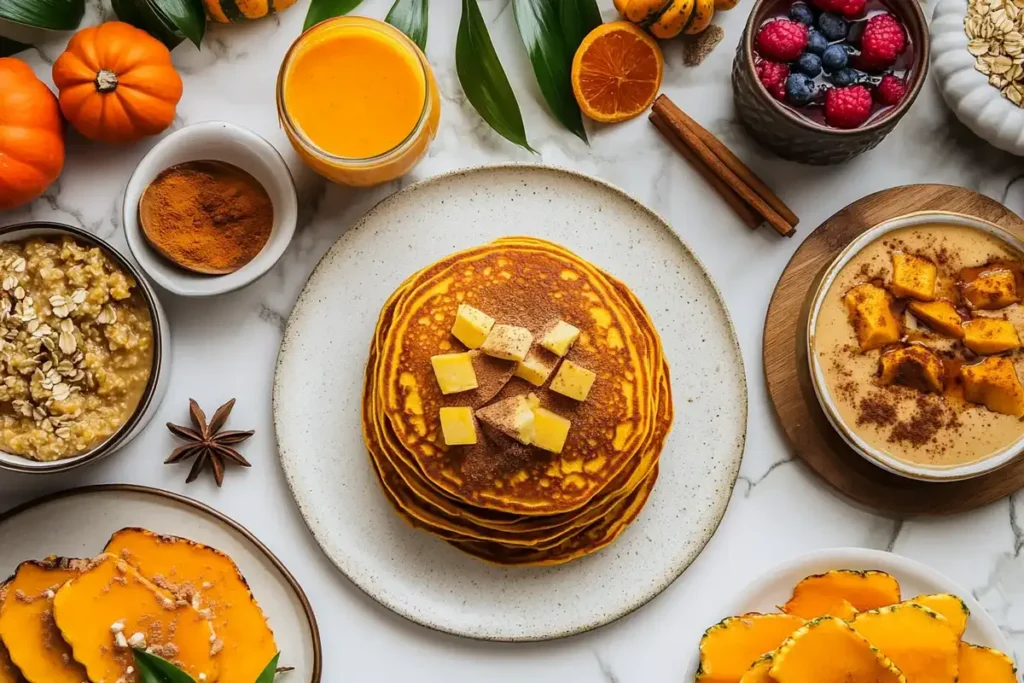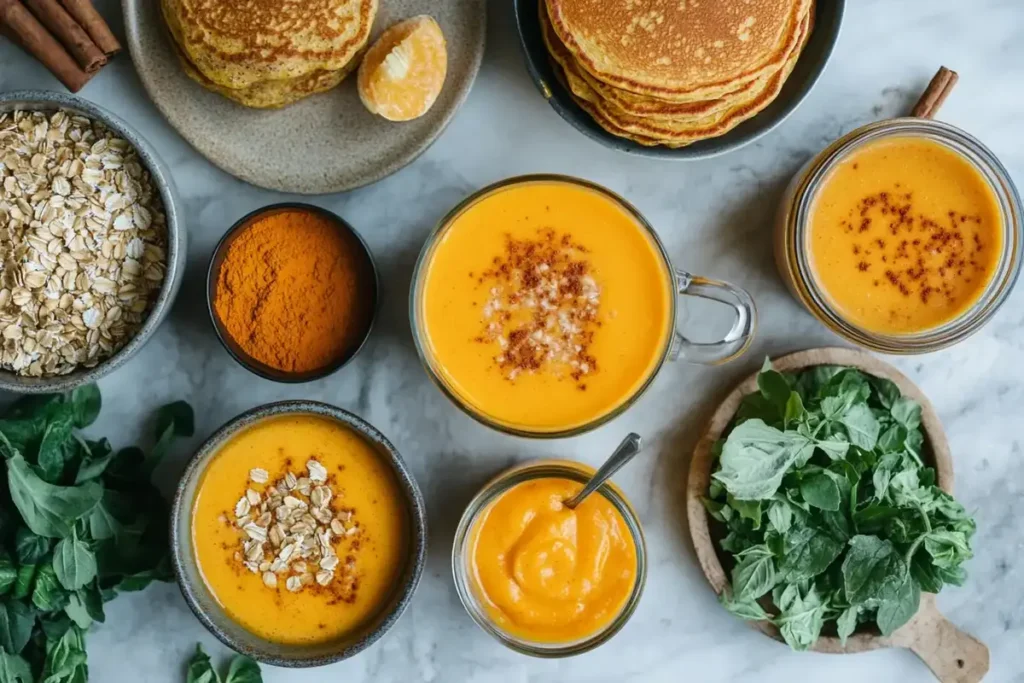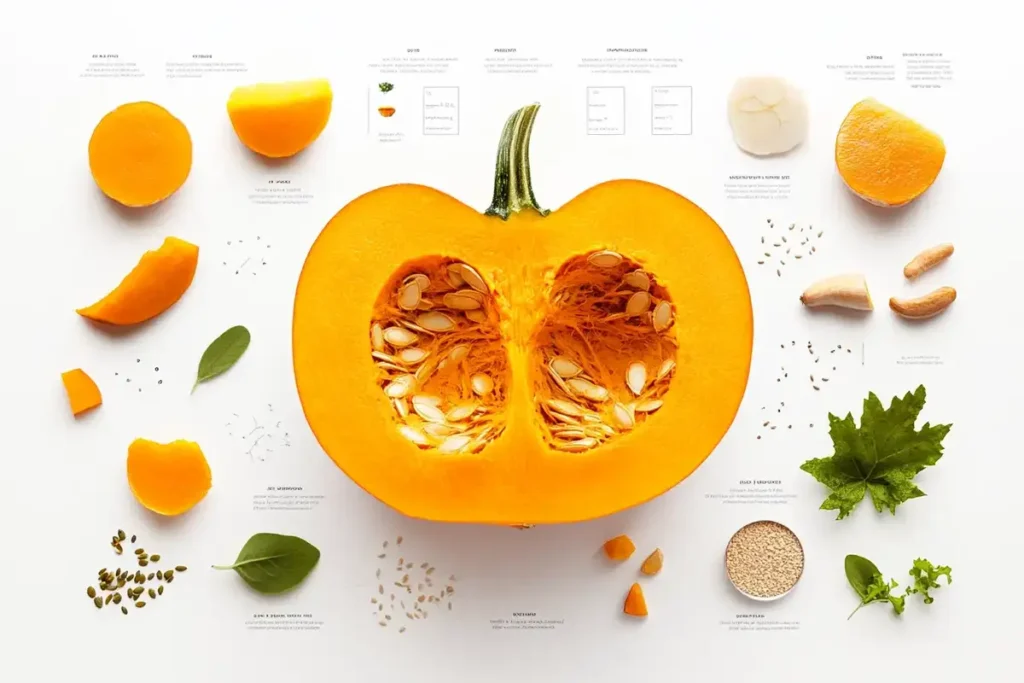Pumpkin is not just a seasonal delight but also a powerhouse of nutrients that deserves a spot on your breakfast table. Many people wonder, is it good to eat pumpkin for breakfast? This article dives deep into the health benefits, nutritional value, and creative ways to incorporate pumpkin into your morning routine. By the end, you’ll have the answers, recipes, and motivation to make pumpkin a breakfast staple.
Introduction to Eating Pumpkin for Breakfast
Overview of Pumpkin as a Breakfast Food
Starting your day with pumpkin can be a game-changer for your health and taste buds. This versatile vegetable, technically a fruit, has earned its place as a nutritional superstar. From hearty porridge bowls to energizing smoothies, pumpkin effortlessly adapts to a variety of breakfast dishes. Its natural sweetness makes it a healthier alternative to refined sugar, while its low-calorie density and rich fiber content make it ideal for those watching their weight.
Not just a seasonal trend, pumpkin has long been cherished in culinary traditions worldwide. In some cultures, it’s a breakfast staple, often used in soups, stews, or steamed dishes. Its combination of mild flavor and creamy texture makes it a universal ingredient, easy to pair with both sweet and savory breakfasts.
Pumpkin’s reputation as a “superfood” isn’t just hype—it’s a reality backed by its impressive nutrient profile. Packed with vitamin A, potassium, and antioxidants like beta-carotene, pumpkin supports everything from eye health to immune function. When eaten in the morning, it provides essential nutrients to fuel your day while keeping you full and satisfied.
Popularity and Cultural Significance
Pumpkin holds a special place in culinary and cultural history, especially in regions with a temperate climate. While it’s celebrated as a quintessential autumn ingredient, its importance goes far beyond seasonal recipes. For centuries, pumpkins have symbolized abundance and nourishment. In fact, indigenous communities in North and Central America revered pumpkins as a vital part of their diet, incorporating them into everyday meals.
Today, pumpkin is not just a nostalgic fall favorite but also a trending ingredient among health-conscious foodies. Its association with comfort and warmth makes it especially popular during cooler months. Foods like pumpkin spice lattes, pies, and muffins are synonymous with festive cheer, yet pumpkin’s true potential as a health food is often overlooked.
Adding pumpkin to your breakfast isn’t just about following trends—it’s a simple way to boost your nutrient intake. From traditional pumpkin soup to modern granola bowls, it continues to evolve as a versatile ingredient that meets the needs of diverse palates and dietary preferences.
Why Choose Pumpkin for Breakfast?
Eating pumpkin in the morning offers several unique advantages. It provides a solid nutritional foundation for your day, balancing natural sugars with fiber and essential vitamins. Unlike many breakfast options loaded with artificial sweeteners or empty calories, pumpkin gives you a nutrient-packed start that energizes you without the sugar crash.
Beyond its health benefits, pumpkin is a budget-friendly choice. Whether fresh, frozen, or canned, it’s widely available and affordable, making it accessible for everyone. Plus, it’s easy to prepare—whether roasted, steamed, or blended into a puree, pumpkin’s mild taste and smooth texture make it incredibly adaptable.
Benefits of Eating Pumpkin for Breakfast
Advantages of Including Pumpkin in Breakfast
Pumpkin offers a variety of benefits when incorporated into your breakfast routine. Its nutrient-dense profile ensures you get essential vitamins and minerals to fuel your day. But the perks don’t stop there—pumpkin provides specific advantages that make it an ideal choice for the morning meal.
Sustained Energy Release
Thanks to its complex carbohydrates and low glycemic index, pumpkin provides a slow and steady release of energy. Unlike refined breakfast options that cause quick sugar spikes, pumpkin helps maintain balanced blood sugar levels, keeping you energized throughout the morning. This makes it perfect for long workdays, busy mornings, or anyone seeking lasting energy without the mid-morning crash.
Enhanced Satiety and Reduced Cravings
Pumpkin is naturally rich in dietary fiber, which plays a crucial role in keeping you full longer. Starting your day with a fiber-packed ingredient like pumpkin can curb mid-morning hunger pangs and reduce unhealthy snacking. Its creamy texture and natural sweetness can also satisfy cravings for sugary breakfast options, offering a healthy alternative without compromising on taste.
Supports Digestive Health
Fiber in pumpkin not only promotes fullness but also aids in digestion. It helps regulate bowel movements and fosters a healthy gut environment. This makes pumpkin an excellent choice for individuals dealing with digestive issues or those who prioritize gut health.
Pumpkin’s Role in a Balanced Breakfast
Complements Other Breakfast Foods
Pumpkin works wonderfully with other breakfast staples. It pairs seamlessly with whole grains like oats, proteins such as Greek yogurt, and healthy fats like nuts and seeds. Whether you enjoy it in a smoothie, pancake, or muffin, pumpkin enhances the nutritional value of your breakfast while adding a natural depth of flavor.
Versatility in Various Recipes
Pumpkin’s versatility knows no bounds. From savory dishes like pumpkin frittatas to sweet classics like pumpkin pancakes, the possibilities are endless. Even pumpkin seeds, often overlooked, are a nutrient-rich topping for oatmeal or yogurt bowls. Experimenting with pumpkin allows you to craft unique and delicious meals that cater to your personal tastes and dietary needs.
Potential Considerations When Eating Pumpkin
While pumpkin is generally a healthy choice, there are a few considerations to keep in mind.
Allergies and Sensitivities
Though rare, some people may have allergies to pumpkin or related plants in the squash family. Symptoms can include mild itching, swelling, or, in severe cases, difficulty breathing. If you experience any of these symptoms, consult a healthcare provider before continuing to consume pumpkin.
Glycemic Index and Blood Sugar Levels
Despite its low glycemic load, pumpkin can have a moderate glycemic index, especially when cooked or consumed in larger quantities. For individuals with diabetes or insulin sensitivity, it’s important to pair pumpkin with proteins and healthy fats to slow the absorption of sugars and prevent blood sugar spikes.
Delicious Pumpkin Breakfast Recipes
Popular Pumpkin-Based Breakfast Recipes
Pumpkin can transform ordinary breakfasts into culinary masterpieces with its natural sweetness and nutrient-packed profile. Here are a few popular recipes to inspire your mornings:
Pumpkin Pancakes
Fluffy and golden, pumpkin pancakes are a breakfast favorite. The natural sweetness of pumpkin blends beautifully with spices like cinnamon, nutmeg, and ginger, creating a warm, cozy flavor. Topped with a drizzle of maple syrup or a sprinkle of crushed nuts, these pancakes are as nutritious as they are delicious. Add a side of Greek yogurt for protein and a balanced meal.
Pumpkin Oatmeal
Pumpkin oatmeal combines the creamy richness of oats with the earthy sweetness of pumpkin. Simply stir in pumpkin puree to your cooked oatmeal, and season with pumpkin spice, honey, or chopped dates. For added crunch, sprinkle toasted pumpkin seeds or pecans on top. This hearty dish provides fiber, vitamins, and warmth on cool mornings.

Pumpkin Smoothies
For a quick and refreshing option, pumpkin smoothies are a hit. Blend pumpkin puree with almond milk, a banana, a scoop of protein powder, and a dash of cinnamon. Add some ice cubes or frozen fruit for a chilled treat. This smoothie is not only a nutritional powerhouse but also a perfect grab-and-go breakfast.

How to Prepare Pumpkin for Breakfast
Using Fresh vs. Canned Pumpkin
Both fresh and canned pumpkin can be used in breakfast recipes, but each has its merits. Fresh pumpkin offers a robust flavor and allows you to avoid additives. However, it requires peeling, chopping, and cooking, which takes time. On the other hand, canned pumpkin puree is convenient, consistent in texture, and equally nutritious—just ensure you choose unsweetened varieties without added spices.
Homemade Pumpkin Puree Recipe
To make fresh pumpkin puree, start by cutting a small pumpkin in half, removing the seeds, and baking it at 375°F (190°C) until soft (about 45 minutes). Scoop out the flesh and blend it until smooth. Store in an airtight container in the fridge for up to a week, or freeze for long-term use. Homemade puree is a flavorful base for all your pumpkin breakfast creations.

Incorporating Pumpkin Seeds into Breakfast
Pumpkin seeds, or pepitas, are a nutritional gem that often accompanies pumpkin in recipes. They’re an excellent addition to any breakfast, adding both crunch and health benefits.
Nutritional Benefits of Pumpkin Seeds
Pumpkin seeds are a rich source of magnesium, zinc, and healthy fats. They support heart health, enhance digestion, and provide an excellent source of plant-based protein. These tiny seeds are also packed with antioxidants, making them a perfect complement to pumpkin’s nutrient profile.

Recipe Ideas with Pumpkin Seeds
Use pumpkin seeds as a topping for yogurt, oatmeal, or smoothie bowls for a crunchy texture and added nutrients. They can also be toasted with a sprinkle of salt or cinnamon for a snackable garnish. For a savory option, incorporate them into avocado toast or blend them into homemade granola.
Addressing Common Questions and Conclusion
Frequently Asked Questions About Eating Pumpkin for Breakfast
Can pumpkin be eaten raw for breakfast?
Yes, pumpkin can be eaten raw, but its texture is firm and slightly bland. For a more palatable option, try shredding raw pumpkin into salads or blending it into smoothies. Just be sure to wash it thoroughly to remove any pesticides or residues.
Does pumpkin help with weight loss?
Absolutely! Pumpkin is low in calories and high in fiber, making it an excellent choice for weight management. Its fiber content promotes satiety, helping you feel full longer and curbing unhealthy snacking habits. Additionally, its nutrient density supports overall health during a calorie deficit.
Is it healthy to eat pumpkin every day?
Yes, eating pumpkin daily can be healthy due to its rich content of vitamin A, fiber, and antioxidants. However, moderation is key. Consuming excessive amounts of vitamin A can lead to toxicity over time. Pair pumpkin with a variety of other nutrient-rich foods to maintain a balanced diet.
Are there any side effects of eating too much pumpkin?
While pumpkin is nutritious, consuming it in large quantities might cause a yellowish tint to the skin due to its high beta-carotene content. For individuals with sensitive digestion, excess fiber from pumpkin might lead to bloating or gas. Balance is crucial to enjoy its benefits without side effects.
How can I store leftover pumpkin puree?
Store leftover pumpkin puree in an airtight container in the refrigerator for up to one week. For longer storage, portion the puree into freezer-safe bags or containers, and freeze for up to three months. Defrost as needed for quick recipes.
Conclusion
Summary of Benefits
Pumpkin is a nutritional powerhouse that offers numerous benefits when incorporated into your breakfast. From providing sustained energy to supporting digestion and weight loss, it’s an ingredient that deserves a spot in your morning routine. Its versatility allows it to shine in both sweet and savory dishes, catering to various tastes and preferences.
Encouragement to Incorporate Pumpkin into Breakfast
Embracing pumpkin as a breakfast staple is an easy and delicious way to prioritize your health. Whether you enjoy it as a hearty bowl of oatmeal, a refreshing smoothie, or a comforting stack of pancakes, pumpkin’s natural flavors and health benefits make it an unbeatable choice. So why not add a little pumpkin to your mornings and see the difference it makes in your day?

